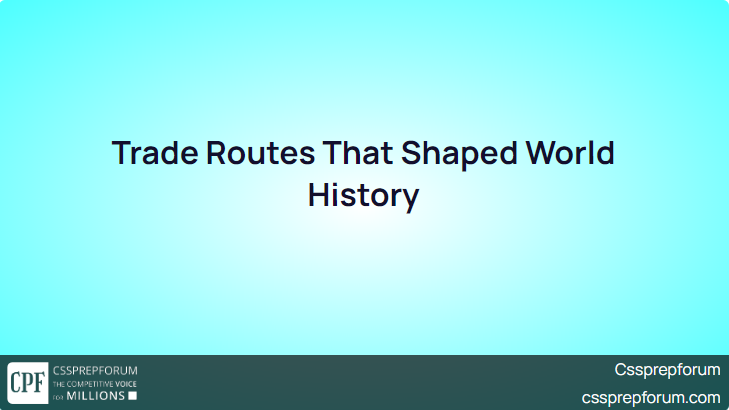Written by John.
Trade routes have occurred throughout early history, linking production places to the places of trade. Although scarce economic goods available only in particular areas, such as spices, salts, etc., were the main products to trade networks, these routes, when established, also promoted the exchange of cultural goods. That resulted in the spread of ideas, knowledge, religion, and sometimes even bacteria. In this article, four trade routes are mentioned that played a vital role in shaping the World History.

1. THE SILK ROAD
The most well-known ancient trade route The Silk Road connects the great ancient civilizations of the Roman Empire and China. Since the first century BCE – Before Common Era, China traded Silk to the Roman Empire in exchange for silver, gold, and wool from Europe. The Silk Road, along with promoting trade, became an essential path for the spread of religion, ideas, technology, knowledge, and arts too. Many trading centers along the silk route, such as Samarkand in present-day Uzbekistan, also became vital centers of intellectual exchange.
The ancient Silk Route, also known as Silk Road, was a series of classical trade networks that connected Far Eastern countries with Europe and the Middle East. The route had a combination of trading posts and markets used to help transport, storage, and exchange of goods. Only a few traders were capable of covering the full 4000 miles route; however, others plied their trade on the course sections. In the fourth century CE – Common Era, when the Roman Empire collapsed due to the rise of Arabian power in Lavent, the Silk Road became unsafe and moldered for being out of use until the 13th century. In the 13th century, the route was revived under the Mongols; it was when the Italian explorer Marco Polo followed the Silk Road and became one of the initial Europeans to visit China. The trade route also has had a dark side in history; it might have spread more than trade and culture. Some scientists believe the plague bacteria that caused the Black Death were spread by the traders traveling along the Silk Road.
2. THE SPICE ROUTES
In contrast to the other trade routes mentioned in this article, the Spice Routes, also known as Maritime Roads, is the name given to the network of sea routes linking the East to the West. Cinnamon, nutmeg, cloves, and pepper were the highly demanded commerce goods in Europe; however, before the 15th century, the middlemen of North Africa and Arab acquired space to trade with the East. They made these spices immensely high-priced and rare. During the 15th to 17th centuries, when the age of Exploration dawned and sailing along long distances wasn’t rare anymore, Europeans directed towards the seas to form first-hand trading links with China, Japan, and Indonesia. It is also believed it was the Spices Routes that encouraged and powered the development of speedy boats; they also invigorated the discovery of new lands. They promoted new diplomatic bonds between East and West.
The Dutch and English were the two who were mainly profited when modern-day Indonesia, especially the Moluccas, also called Spices Islands – which was the mere source of cloves and nutmeg at that time – made control over the spice trade. This trade route is one of the most remarkable courses in terms of globalization because of the wars fought, lands colonized, and fortunes made, on the back of the spice trade.
3. THE INCENSE ROUTE
The Incense Route was developed for the transport of frankincense and myrrh, goods found only in the Arabian Peninsula’s southern end, present Yemen and Oman. Both the items frankincense and myrrh are derived from the sap of tree dried in the Sun. The dried nuggets of sap can either be used as a perfume or burned as incense; these nuggets were also used to give a pleasant fragrance to dead bodies, acting as an aid in burial rituals – customs performed before burying a dead body. The tradition of keeping camel as pets started around 1000 BCE. This advancement permitted the Arabs to begin trading their precious incense to a supreme trade hub, the Mediterranean. For the Romans, Egyptians, and Greeks, frankincense and myrrh soon became remarkable commodities. During his reign, the Roman emperor Nero had a whole year’s reaping of frankincense burned at the burial of his darling wife.
The trade thrived; the overland path was in its primes. At that time, the route was said to have seen nearly 3000 tons of the commodity, incense, annually transported through its stretch. Pliny the Elder, a Roman historian, wrote that the route was completed in 62 days; however, it’s evident that sometimes, the exact path shifted when rapacious settlements belled the cat. Massive taxes were demanded that were too high from the caravans coming through. Since the first century CE, this old overland course was no longer useful as the advanced design of boats made maritime routes more captivating.
4. THE AMBER ROAD
Amber – a fossilized tree resin, much valued from ancient times to the present as a gemstone – has been traded since almost 3000 BCE. The archaeological shreds of evidence reveal that, from Baltics, amber beads were transported to far-away places, including Egypt. To a great extent, the Romans were influenced by the amber stone for its decorative and medicinal purposes. Its value for them can be identified from the reality that they established a route that linked Baltics with the rest of Europe. The route was named ‘the Amber Road.’
Thousands of years ago, when woods covered the area, immense deposits of amber were formed under the Baltic Sea. Amber washes to land from the direction of the sea, and can also be harvested from the beaches located in Baltic. That is how most of the local amber traders set up their business and earn a living. Also, for the Teutonic Knights, the Baltic became an essential source of income in the 12th and 13th centuries, during the crusades; the Knights were bestowed control of the region where this precious element was produced. However, it didn’t seem to be a good idea. The knights viciously victimized the local Prussians and set anyone who tried to harvest or trade amber to death. At present, one can find the remains of the ancient Amber Road in Poland. Moreover, one of the primary routes of Poland is known as the “Amber Highway.”
Are you looking to learn English communication skills to qualify for the CSS and PMS English essay & Precis papers? Let’s join Sir Syed Kazim Ali and learn how to give your ideas and thoughts words, fluently and confidently.
CSS & PMS 2024 Extensive English Course













